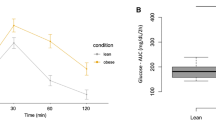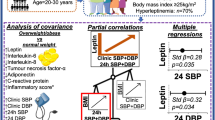Abstract
Background/Objectives
The role of spexin (SPX) in energy metabolism, endocrinal homeostasis, and vasculopathy is emerging. However, scarce data are available about its role in childhood obesity and obesity-related vasculopathy. Hence, we aimed to assess the level of SPX in obese and normal-weight children, and to correlate it with aortic distensibility (AD) and aortic stiffness index (ASI).
Subjects/Methods
Forty obese children were compared to 40 matched normal-weighed children. Weight, height, and body mass index (BMI) z score and mean blood pressure (Bl-Pr) percentile on three different occasions were obtained. SPX, fasting triglycerides, cholesterol, low-density (LDL), high-density lipoproteins (HDL), and insulin were measured with calculation of the homeostatic model assessment insulin resistance (HOMA-IR). Internal aortic diameter was measured with calculation of AD, strain (AS), and ASI.
Results
Children with obesity had significantly lower SPX (P = 0.004), HDL (P < 0.001), and AD (P < 0.001) and higher systolic Bl-Pr (P < 0.001), diastolic Bl-Pr (P < 0.001), LDL (P = 0.011), HOMA-IR (P < 0.001), and ASI (P < 0.001). Significant negative correlation was found between SPX and BMI z score (r = −0.646, P < 0.001), systolic Bl-Pr (r = −0.641, P < 0.001), diastolic Bl-Pr (r = −0.427, P < 0.001), HOMA-IR (r = −0.349, P = 0.028), and ASI (r = −0.389, P = 0.013), while significant positive correlation was found between SPX and AS (P < 0.001, r = 0.633) and AD (P < 0.001, r = 0.612). However, no significant correlation was found between SPX and age (r = −0.01, P = 0.953), TG (r = 0.048, P = 0.767), total cholesterol (r = −0.023, P = 0.887), LDL (r = −0.299, P = 0.061), and HDL (r = 0.193, P = 0.232).
Conclusions
Children with obesity had significantly lower SPX than controls. SPX was correlated with BMI, Bl-Pr, HOMA-IR, and vasculopathy in children with obesity independent of their age and lipid profile. Further studies should explore the pathomechanism of SPX and its potential role in the management of obesity and obesity-related cardiometabolic risk.
This is a preview of subscription content, access via your institution
Access options
Subscribe to this journal
Receive 12 print issues and online access
$259.00 per year
only $21.58 per issue
Buy this article
- Purchase on Springer Link
- Instant access to full article PDF
Prices may be subject to local taxes which are calculated during checkout
Similar content being viewed by others
Data availability
Data will be available upon request.
References
Jung U, Choi M. Obesity and its metabolic complications: the role of adipokines and the relationship between obesity, inflammation, insulin resistance, dyslipidemia and nonalcoholic fatty liver disease. Int J Mol Sci. 2014;15:6184–223. https://doi.org/10.3390/ijms15046184.
Kumar S, Hossain J, Nader N, Aguirre R, Sriram S, Balagopal PB. Decreased circulating levels of spexin in children with obesity. J Clin Endocrinol Metab. 2016;101:2931–6.
Koskinen J, Kytö V, Juonala M, Viikari J, Nevalainen J, Kähönen M, et al. Childhood risk factors and carotid atherosclerotic plaque in adulthood: The Cardiovascular Risk in Young Finns Study. Atherosclerosis. 2020;293:18–25. https://doi.org/10.1016/j.atherosclerosis.2019.11.029. ISSN 0021-9150.
Cote A, Harris K, Panagiotopoulos C, Sandor G, Devlin A. Childhood obesity and cardiovascular dysfunction. J Am Coll Cardiol. 2013;62:1309–19.
Chen T, Wang F, Chu Z, Sun L, Lv H, Zhou W, et al. Circulating spexin and negatively correlated with systemic insulin sensitivity and pancreatic ß cell function in children with obesity. Ann Nutr Metab. 2019;74:125–31.
Rodriguez-Leal C, Monsalvo-Hernando M, Tinoco-Racero I, Segura E, Caro N, Carballo M, et al. Adipokines and cytokines serum levels in children and adolescents and its relationship with obesity. Atherosclerosis. 2016;252:e129. https://doi.org/10.1016/j.atherosclerosis.2016.07.666.
Mirabeau O, Perlas E, Severini C, Audero E, Gascuel O, Possenti R, et al. Identification of novel peptide hormones in the human proteome by hidden Markov model screening. Genome Res. 2007;17:320–7.
Lim CH, Lee MYM, Soga T, Parhar I. Evolution of structural and functional diversity of spexin in mammalian and non-mammalian vertebrate species. Front Endocrinol (Lausanne). 2019;10:379. https://doi.org/10.3389/fendo.
Lv S, Zhou Y, Zhang X, Chen W, Wang Y. Emerging roles of NPQ/spexin in physiology and pathology. Front Pharmacol. 2019;10:457. https://doi.org/10.3389/fphar.2019.00457.
Bitarafan V, Esteghamati A, Azam K, Yosaee S, Djafarian K. MON-P215: comparison of the serum spexin concentration in metabolic syndrome patients with the control groups. Clin Nutr. 2016;35:S232.
Ge JF, Walewski JL, Anglade D, Berk PD. Regulation of hepatocellular fatty acid uptake in mouse models of fatty liver disease with and without functional leptin signaling: roles of NfKB and SREBP-1C and the effects of spexin. Semin Liver Dis. 2016;36:360–72.
Lin CY, Huang T, Zhao L, Lam WC, Fan BM, Bian ZX. Circulating spexin levels negatively correlate with age, BMI, fasting glucose, and triglycerides in healthy adult women. J Endocr Soc. 2018;2:409–19.
Gu L, Ma Y, Gu M, Zhang Y, Yan S, Li N, et al. Spexin peptide is expressed in human endocrine and epithelial tissues and reduced after glucose load in type 2 diabetes. Peptides. 2015;71:232–9.
Al-Daghri N, Sabico S, Al-Hazmi H, Alenad A, Al-Amro A, Al-Ghamdi A, et al. Circulating spexin levels are influenced by the presence or absence of gestational diabetes. Cytokine. 2019;113:291–5. https://doi.org/10.1016/j.cyto.2018.07.023.
Hodges S, Teague A, Dasari P, Short K. Effect of obesity and type 2 diabetes, and glucose ingestion on circulating spexin concentration in adolescents. Pediatr Diabetes. 2018;19:212–6. https://doi.org/10.1111/pedi.12549.
Kumar S, Hossain MJ, Javed A, Kullo IJ, Balagopal PB. Relationship of circulating spexin with markers of cardiovascular disease: a pilot study in adolescents with obesity. Pediatr Obes. 2018;13:374–80.
Behrooz M, Vaghef-Mehrabany E, Ostadrahimi A. Different spexin level in obese vs normal weight children and its relationship with obesity related risk factors. Nutr Metab Cardiovasc Dis. 2020;30:674–82. https://doi.org/10.1016/j.numecd.2019.11.008.
World Health Organization. Department of Nutrition for Health and Development. WHO Child Growth Standards. Length/height-for-age, weight-for-age, weight-for-length, weight-for-height, and body mass index-for-age. Methods and Development. Geneva. 2006;301–4.
Flynn J, Kaelber D, Baker-Smith C, Blowey D, Carroll A, Daniels S, et al. Clinical practice guideline for screening and management of high blood pressure in children and adolescents. Pediatrics. 2017;140:e20171904. https://doi.org/10.1542/peds.2017-1904.
Friedewald WT, Levi RI, Fredrickson DS. Estimation of the concentration of low density lipoproteins cholesterol in plasma without use of the ultracentrifuge. Clin Chem. 1972;18:499–502.
Myśliwiec M, Walczak M, Malecka-Tendera E, Dobrzańska A, Cybulska B, Filipiak K, et al. Management of familial hypercholesterolemia in children and adolescents. Position paper of the Polish Lipid Expert Forum. J Clin Lipidol. 2013;8:173–80. https://doi.org/10.1016/j.jacl.2014.01.001.
Cuartero GB, Lacalle GC, Lobo JC, Vergaz GA, Rey CC, Villar MJ. The HOMA and QUICKI indexes, and insulin and C-peptide levels in healthy children. Cut off points to identify metabolic syndrome in healthy children. Pediatr (Barc). 2007;66:481–90.
Gürel E, Tigen K, Karaahmet T, Gecmen C, Mutlu B, Bulut M, et al. Aortic elastic properties predict occult coronary artery disease: a multi detector row computed tomography study. Kardiol Pol. 2015;73:101–8.
Lin CY, Zhang M, Huang T, Yang LL, Fu HB, Zhao L, et al. Spexin enhances bowel movement through activating L-type voltage-dependent calcium channel via galanin receptor 2 in mice. Sci Rep. 2015;5:12095. https://doi.org/10.1038/srep12095.
Ma A, Bai J, He M, Wong A. Spexin as a neuroendocrine signal with emerging functions. Gen Comp Endocrinol. 2018;265:90–6. https://doi.org/10.1016/j.ygcen.
Reyes-Alcaraz A, Lee YN, Son GH, Kim NH, Kim DK, Yun S, et al. Development of spexin-based human galanin receptor type II-specific agonists with increased stability in serum and anxiolytic effect in mice. Sci Rep. 2016;6:21453. https://doi.org/10.1038/srep21453.
Karaca A, Bakar-Ates F, Ersoz-Gulcelik N. Decreased spexin levels in patients with type 1 and type 2 diabetes. Med Princ Pract. 2018;27:549–54.
Ge JF, Walewski JL, Anglade D, Berk PD. Regulation of hepatocellular fatty acid uptake in mouse models of fatty liver disease with and without functional leptin signaling: roles of NfKB and SREBP-1C and the effects of spexin. Semin Liver Dis. 2016;36:360–72. https://doi.org/10.1055/s-0036-1597248.
Al-Daghri NM, Al- Hazmi HA, Al – Ajlan A, Masoud MS, Al- Amro A, Al- Ghamdi A, et al. Associations of spexin and cardiometabolic parameters among women with and without gestational diabetes mellitus. Saudi J Biol Sci. 2018;25:710–4.
Cercato C, Fonseca F. Cardiovascular risk and obesity. Diabetol Metab Syndr. 2019;11:74.
Liu Y, Sun L, Zheng L, Su M, Liu H, Wei Y, et al. Spexin protects cardiomyocytes from hypoxia-induced metabolic and mitochondrial dysfunction. Naunyn Schmiedebergs Arch Pharmacol. 2020;393:25–33. https://doi.org/10.1007/s00210-019-01708-0.
Author information
Authors and Affiliations
Contributions
NYS: methodology, investigation, and writing (reviewing and editing), DAZ: data curation and writing (original draft), RNS: investigation and project visualization, RFF: preparation and visualization, MAE: resources, software, and validation, EA: resources and investigation, AAO: resources and investigation, and YGEG: conceptualization, software, and supervision.
Corresponding author
Ethics declarations
Conflict of interest
The authors declare no competing interests.
Informed consent
Informed consent was obtained from all patients or their legal guardians for being included in the study.
Additional information
Publisher’s note Springer Nature remains neutral with regard to jurisdictional claims in published maps and institutional affiliations.
Supplementary information
Rights and permissions
About this article
Cite this article
Salah, N.Y., Zeid, D.A., Sabry, R.N. et al. Circulating spexins in children with obesity: relation to cardiometabolic risk. Eur J Clin Nutr 76, 119–125 (2022). https://doi.org/10.1038/s41430-021-00912-7
Received:
Revised:
Accepted:
Published:
Issue Date:
DOI: https://doi.org/10.1038/s41430-021-00912-7



